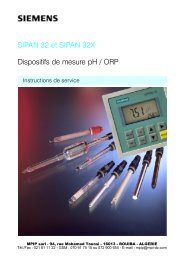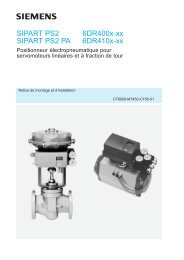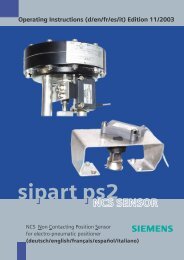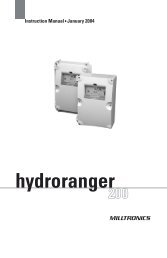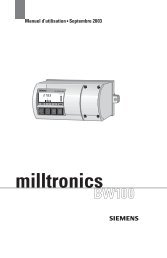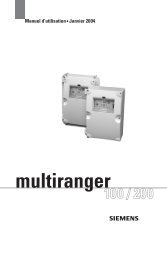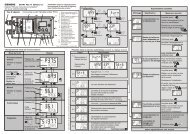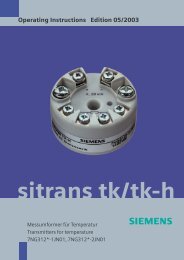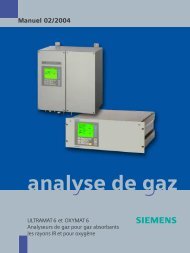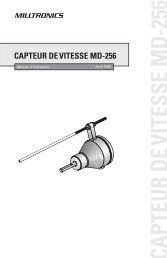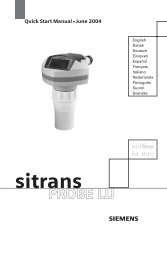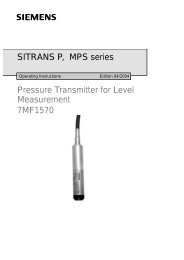FLK Gas Sampling System - MPIP - Free
FLK Gas Sampling System - MPIP - Free
FLK Gas Sampling System - MPIP - Free
- No tags were found...
Create successful ePaper yourself
Turn your PDF publications into a flip-book with our unique Google optimized e-Paper software.
SQ250 <strong>FLK</strong> <strong>Gas</strong> <strong>Sampling</strong> <strong>System</strong><br />
If a retraction device is used, then the filter must be fitted with the fixing bracket at a distance of approx. 10 cm to the<br />
measuring gas connection of the probe. It should be ensured that the two measuring gas connections are positioned<br />
exactly opposite.<br />
The valve combination must be mounted in the immediate vicinity of the probe and the filter. The joining<br />
contained in the supplied items must be used to obtain proper functioning.<br />
• The two purging connections between the filter and the valve combination are joined with the two stainless steel<br />
corrugated hoses (3/4" and 1/2" connections).<br />
• The connection from the filter to the condensate separator is implemented with TEFLON pipe or with PTFE pressure<br />
hose depending on the version.<br />
• TEFLON pipe: Here the PTFE screw-on gland for the pipe connection is screwed onto the adjustable angular gland on<br />
the filter. The PTFE angular screw-in gland is screwed into the condensate separator. These must be joined with the<br />
TEFLON pipe such that it does not break off and runs slightly slanting to the condensate separator.<br />
pieces<br />
Note:<br />
All screw glands for the measuring gas must be sealed with TEFLON.<br />
• PTFE pressure hose: This PTFE pressure hose is provided with M16x1.5 union nuts at both ends. With this<br />
the PTFE pressure hose is connected directly to the screw-glands on the filter and condensate vessel.<br />
If an electrically heated measuring gas line is used between the probe and the analyzer cabinet, then it must be<br />
connected directly to the filter. When carrying this out, the ERMETO screw glands contained in the supplied<br />
items can be used. The measuring gas line must be restrained at the valve combination so that the complete<br />
load does not fall on the joining piece.<br />
• The connection between the valve combination and the pneumatic limit switch consists of the ready-made compressed air<br />
lines with conical nipples and union nuts. With the pneumatic limit switch attention must be paid to the connections. The<br />
second connection "A" must be sealed with the stop-plug.<br />
• The connection between the valve combination and pneumatic motor is made with the third ready-made compressed air<br />
line.<br />
2.6 Laying the coolant line to the probe<br />
With the movable feed lines to the traversable probe it must be ensured that the complete traversing range remains free<br />
without any hindrance due to the lines. The laying of the feed lines must be carried out very carefully.<br />
Note: With the relevant mounting plan and the types of installation stated in the mounting instructions, nonmandatory<br />
suggestions are given, since normally the local conditions demand adaptation of the line routing.<br />
The main points to be considered are as follows:<br />
• setting up of the coolant hoses as twist-free as possible;<br />
• select the distance between connections not too large, so that hoses are not subject to tensile stresses even in the end<br />
positions;<br />
• within the complete traversing area do not over-bend hoses - the smallest radius is 200 mm;<br />
• do not twist the hoses impermissibly by movement, but instead bend them in the plane of movement as free of twisting<br />
as possible;<br />
• do not place any obstructions in the traversing area;<br />
• the coolant lines must not come into contact with heat-sensitive parts.<br />
Copyright ® SIEMENS Page 12 04/04


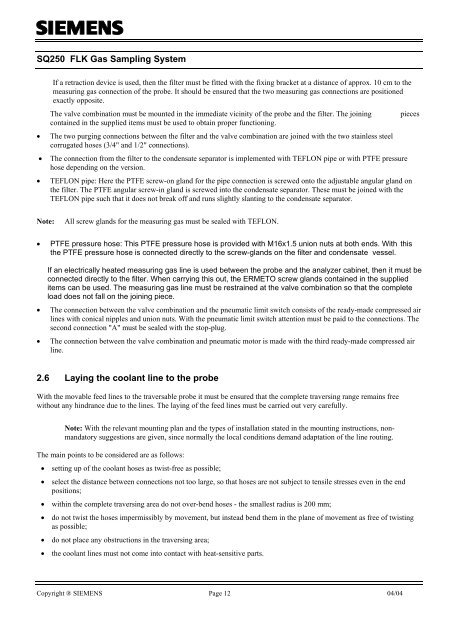
![[ ]](https://img.yumpu.com/53283450/1/184x260/-.jpg?quality=85)
